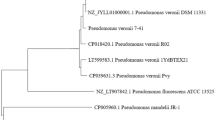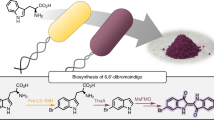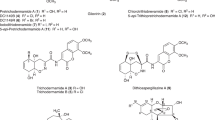Abstract
Cells of Escherichia coli K–12 containing a cloned fragment of Pseudomonas putida TOL plasmid pWW0 produce the dye indigo. Analysis of the cloned fragment and Tn1000 transposon insertion mutagenesis has identified the xylA gene as being responsible for this phenotype. The xylA gene specifies xylene oxidase, a relaxed specificity enzyme that hydroxylates or monooxygenates toluene and xylenes and their corresponding alcohols. Indole, which is formed from tryptophan by tryptophanase in E. coli, was shown to be a precursor in the reaction sequence leading to indigo formation. These results suggest a novel route for bacterial production of indigo via hydroxylation of indole.
This is a preview of subscription content, access via your institution
Access options
Subscribe to this journal
Receive 12 print issues and online access
$209.00 per year
only $17.42 per issue
Buy this article
- Purchase on Springer Link
- Instant access to full article PDF
Prices may be subject to local taxes which are calculated during checkout
Similar content being viewed by others
References
Gray, P.M.M. 1928. The formation of indigotin from indol by soil bacteria. Proc. Royal Soc. London, Ser. B 102:2263–2279.
Oshima, T., Kawai, S. and Egani, F. Oxidation of indole to indigotin by Pseudomonas indoloxidans . 1965. J. Biol. Chem. 58:259–263.
Ensley, B.D., Ratzkin, B.J., Osslund, T.D., Simon, M.J., Wackett, L.P. and Gibson, D.T. 1983. Expression of naphtalene oxidation genes in Escherichia coli results in the biosynthesis of indigo. Science 222:167–169.
Worsey, M.J. and Williams, P.A. 1975. Metabolism of toluene and xylenes by Pseudomonas putida (arvilla) mt–2: evidence for a new function of the TOL plasmid. J. Bacteriol. 124:7–13.
Kunz, D.A. and Chapman, P.J. 1981. Isolation and characterization of spontaneously occuring TOL plasmid mutants of Pseudomonas putida HS1. J. Bacteriol. 146:179–191.
Murray, K., Duggleby, C.J., Sala–Trepat, J.M. and Williams, P.A. 1972. The metabolism of benzoate and methylbenzoates via the meta–cleavage pathway by Pseudomonas arvilla mt–2. Eur. J. Biochem 28:301–310.
Franklin, F.C.H., Bagdasarian, M., Bagdasarian, M.M. and Timmis, K.N., 1981. Molecular and functional analysis of the TOL plasmid pWW0 from Pseudomonas putida and cloning of genes for the entire regulated aromatic ring meta cleavage pathway. Proc. Natl. Acad. Sci. USA, 78:7458–7462.
Inouye, S., Nakazawa, A. and Nakazawa, T. 1981. Molecular cloning of TOL genes xy1B and xy1E in Escherichia coli . J. Bacteriol. 145:1137–1143.
Inouye, S., Ebina, Y., Nakazawa, A. and Nakazawa 1984. Nucleotide sequence surrounding transcription initiation site of xy1ABC operon on TOL plasmid of Pseudomonas putida . Proc. Natl. Acad. Sci. USA 81:1688–1691.
Worsey, M.J., Franklin, F.C.H. and Williams, P.A. 1978. Regulation of the degradative pathway enzymes coded for by the TOL plasmid (pWW0) from Pseudomonas putida mt–2. J. Bacteriol. 134:757–764 (1978).
Maniatis, T., Fritsch, E.F. and Sambrook, J., Molecular Cloning, A Laboratory Manual. 1982. Cold Spring Harbor, New York.
Meulien, P., Downing, R.G. and Broda, P. 1981. Excision of the 40kb segment of the TOL plasmid pWW0 from Pseudomonas putida mt–2 involves direct repeats. Molec. Gen. Genet. 184:97–101.
Franklin, F.C.H., Lehrbach, P.R., Lurz, R., Rueckert, B., Bagdasarian, M. and Timmis, K.N. 1983. Localization and functional analysis of transportation mutations in regulatory genes of the TOL catabolic pathway. J. Bacteriol. 154:676–685.
Gasson, M.J. and Willetts, N.S. 1977. Further characterization of the F fertility inhibition systems of “unusual” fin+ plasmids. J. Bacteriol. 131:413–420.
Newton, W.A. and Snell, E.E. 1964. Catalytic properties of tryptophanase, a multifunctional pyridoxal phosphate enzyme. Proc. Natl. Acad. Sci. USA 51:382–389.
Bilezikim, J.P., Kaempfer, O.R. and Magasanik, B. 1967. Mechanism of tryptophanase induction in Escherichia coli . J. Mol. Biol. 27:495–506.
Yanofsky, C.Y., Kelley, R.L. and Horn, V. 1984. Repression is relieved before attenuation in the trp operon of Escherichia coli as tryptophan starvation becomes increasingly severe. J. Bacteriol. 158:1018–1024.
Harayama, S., Lehrbach, P.R. and Timmis, K.N. 1984. Transposon mutagenesis analysis of meta–cleavage pathway operon genes of the TOL plasmid of Pseudomonas putida mt–2. J. Bacteriol. 160:251–255.
Remaut, E., Stanssens, P. and Fiers, W. 1983. Inducible high level synthesis of mature human fibroblast interferon in Escherichia coli . Nucleic Acids Res. 11:4677–4688.
Remaut, E., Tsao, H. and Fiers, W. 1983. Improved plasmid vectors with a thermoinducible expression and temperature–regulated runaway replication. Gene 22:103–113.
Witkop, B. and Patrick, J.B. 1951. Addition reactions and Wagner–Meerwein rearrangement in the indoxyl series. J. Amer. Chem. Soc. 73:713–718.
May, S.W. and Abbott, B.J. 1973. Enzymic epoxidation. II. Comparison between the epoxidation and hydroxylation reactions catalyzed by the w–hydroxylation system of Pseudomonas oleovorans . J. Biol. Chem. 218:1725–1730.
Reineke, W. and Knackmuss, H.–J. . 1978. Chemical structure and biodegradability of halogenated aromatic compounds. Substituent effect on dehydrogenation of 3,5–cyclohexadiene–1,2–diol–1–carboxylic acid. Biochim. Biophys. Acta 542:412–423.
Lehrbach, P.R., Zeyer, J., Reineke, W., Knackmuss, H.–J. and Timmis, K.N. 1984. Enzyme recruitment in vitro: use of cloned genes to extend the range of haloaromatics degraded by Pseudomonas sp. strains B13. J. Bacteriol. 158:1025–1032.
Timmis, K.N., Lehrbach, P.R., Harayama, S., Don, R.H., Mermod, N., Bas, S., Leppik, R., Weightman, A.J., Reineke, W. and Knackmuss, H.–J. 1985. Analysis and manipulation of plasmid–encoded pathways for the catabolism of aromatic compounds by soil bacteria, p. 719–739 In: Plasmids in Bacteria. Helinski, D. R., Cohen, S. N., Clewell, D. B, Jackson, D. A. and Hollaender, A. (eds). Plenum, New York.
Mermod, N., Lehrbach, P.R., Don, R.H. and Timmis, K.N. 1986. Gene cloning and manipulation in Pseudomonads . In: The Bacteria, Vol. 10. Sokatch, J. R. (ed.). Academic Press, NY.
Iida, A., Harayama, S., Iino, T. and Hazelbauer, G.L. 1984. Molecular cloning and characterization of genes required for ribose transport and utilization in Escherichia coli K–12. J. Bacteriol. 158:674–682.
Harayama, S., Oguchi, T. and Iino, T. 1984. Does Tn10 transpose via the cointegrate molecule? Molec. Gen. Genet. 197:62–66.
Sancar, A. and Rupp, W.D. 1979. Cloning of uvrA, lexC and ssb genes of Escherichia coli . Biochem. Biophys. Res. Comm. 90:123–129.
Author information
Authors and Affiliations
Rights and permissions
About this article
Cite this article
Mermod, N., Harayama, S. & Timmis, K. New Route to Bacterial Production of Indigo. Nat Biotechnol 4, 321–324 (1986). https://doi.org/10.1038/nbt0486-321
Received:
Accepted:
Issue Date:
DOI: https://doi.org/10.1038/nbt0486-321
This article is cited by
-
Application of an efficient indole oxygenase system from Cupriavidus sp. SHE for indigo production
Bioprocess and Biosystems Engineering (2019)
-
Enhancing Indigo Production by Over-Expression of the Styrene Monooxygenase in Pseudomonas putida
Current Microbiology (2016)
-
Biotransformation of Indole and Its Derivatives by a Newly Isolated Enterobacter sp. M9Z
Applied Biochemistry and Biotechnology (2015)
-
Aerobic biotransformation of 3-methylindole to ring cleavage products by Cupriavidus sp. strain KK10
Biodegradation (2015)
-
A genome-scale metabolic reconstruction of Pseudomonas putida KT2440: i JN746 as a cell factory
BMC Systems Biology (2008)



